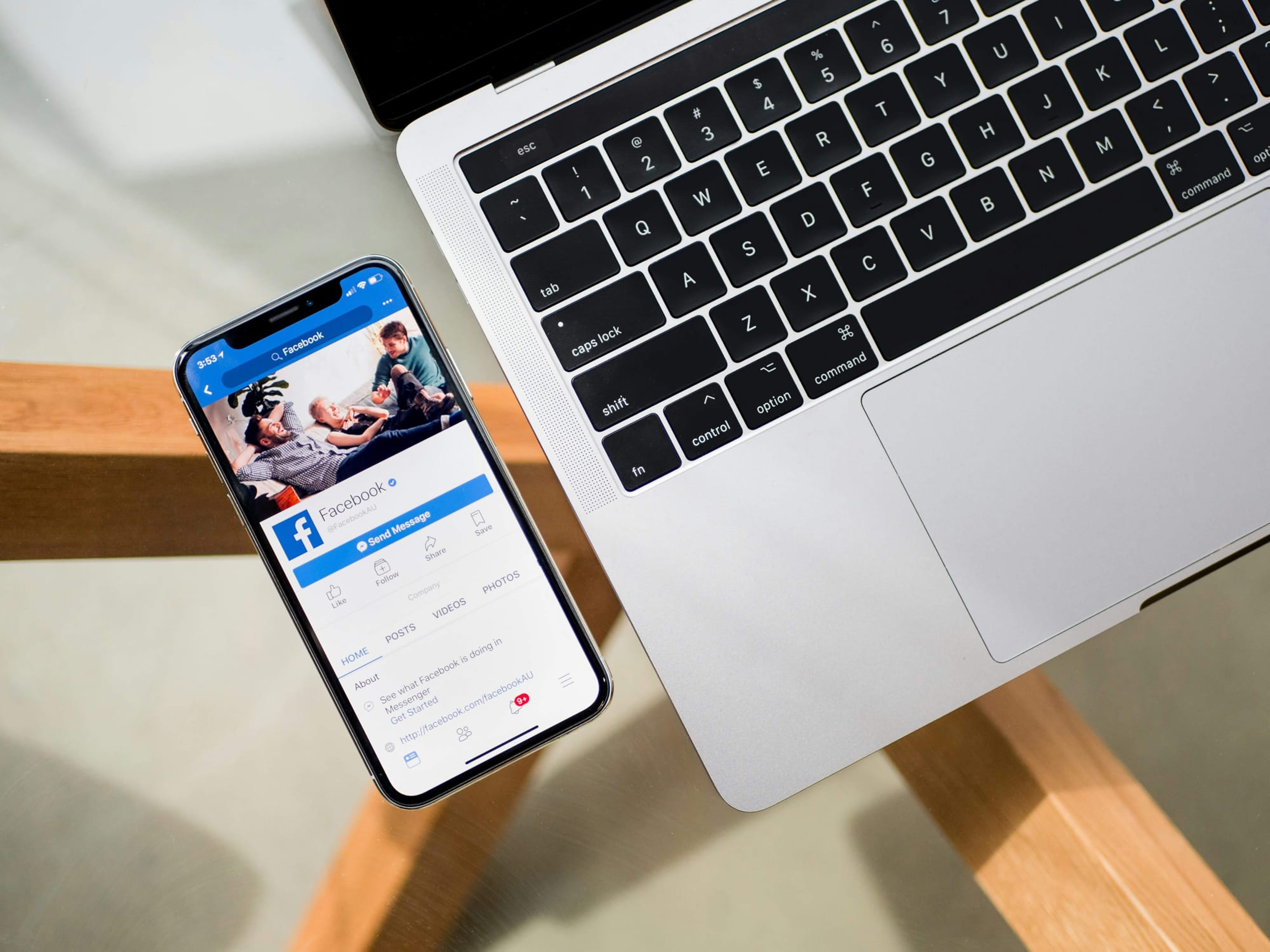Remember good old chronological news feeds? Back in the early days of Facebook, circa 2006 or so, posts were shown pretty much in order of recency when you opened up the social media platform.
Now… well, things are a lot more complicated. Meet: The Facebook algorithm.
The Facebook algorithm, the ranking system that uses machine learning to arrange content in users’ feeds, has evolved since the days of Facebook walls and ‘poking’ your friends. It makes sense — the social networking giant didn’t grow to an eye-watering 3 billion users without figuring out how to show people exactly what they want in their Facebook news feeds (or just "feeds" as Facebook calls them now).
There have been hundreds of Facebook algorithm changes over the years (and will doubtless be hundreds more) to get this process just right.
The Facebook algorithm is the lifeblood of the original social network. It's what makes the platform so more-ish — so it's no surprise that it’s developed an almost mythical status for brands and creators. Is there a secret to getting your content seen by as many people as possible?
The bad news: There isn’t one (that would make for a pretty confusing Facebook experience as a user, after all). This is why it's important for creators and marketers to get to grips with the signals that govern the algorithm and learn to leverage them in their Facebook marketing efforts.
In this article, I’ll unpack everything we know about how the Facebook algorithm works, plus offer some guidance on getting your content the reach it deserves.
Plan, schedule, and analyze your posts to Facebook Pages and Facebook Groups with Buffer's Facebook scheduling and analytics tools.
How the Facebook algorithm works in 2025
The Facebook news feed algorithm was created so that the Meta-owned platform shows users more interesting, relevant content and keep them scrolling on the platform longer. The algorithm values what users value.
“Facebook's goal is to make sure that you see posts from the people, interests, and ideas that you find valuable, whether that content comes from people you're already connected to or from those you may not yet know,” the company says.
To that end, there are three different types of content that will make it into users’ feeds:
- Connected content — content from the people they're friends with or are following, Groups they've joined, and Pages they've liked.
- Recommended content — content Facebook thinks they'll be interested in from Pages and people they don’t already follow.
- Ads — controlled by targeting, rather than 'the' algorithm.
Given this post is about the Facebook algorithm and not Facebook ads, I’ll unpack the first two here.
How the Facebook algorithm ranks ‘connected content’
If a user is your ‘friend’ or likes your Facebook Page or profile, your content may show up in their Home feed as part of the connected content system.
Here’s how Facebook evaluates and ranks your content:
1. Taking inventory
In the first part of this process, the algorithm takes stock. It looks at all the content that could show up in a user’s feed: content shared by their friends, the Pages they follow, and the groups they have joined.
Right from the get-go, content that violates Facebook’s Community Standards is excluded (more on this below).
2. Looking at signals
The second thing the algorithm does is look at ranking factors called ‘signals’ to determine how relevant a piece of content will be to the user. There are thousands of possible signals Facebook considers, but here are some examples:
- When it was posted
- Who posted it
- How much the user interacts with the poster
- What kind of content it is (e.g., link, photo, or video)
- How the user interacts with similar posts
- The user’s current time
- How fast their internet connection is
3. Making predictions
Each of those thousands of signals is then used to make “personalized predictions about which content you'll find most relevant and valuable.”
In other words, the algorithm observes users’ past behavior and predicts how likely they are to take specific actions on this new content. “Our systems predict how likely you are to comment on a post, how likely it is that your friends will comment on the post if you share it, or how likely the post is to spark a conversation or back-and-forth discussion,” Facebook says.
For example, if you run a brand Facebook Page that they follow and visit often, and they regularly share your posts, Facebook knows they’re a fan. They probably want to see more of your content in their feed.
A less obvious example: If a user likes shopping in the afternoons and reacts to more branded posts during that time, Facebook will use that as an indicator to surface more branded posts during that time.
4. Scoring the content
After all that, the algorithm gives a ‘relevance score’ to each piece of content. The higher the content score, the higher in the feed it will surface.
At this point, the algorithm also makes sure to mix up the content so the user’s feed doesn’t get too monotonous — for example, they won’t include consecutive posts from the same creator or several videos one after each other.
Once all the connected content has been logged, analyzed, and ranked the algorithm then starts to throw recommended content into the mix.
Recommended content
Facebook’s recommended content system offers an important opportunity for brands and creators — it’s a chance to draw in new fans and followers without any ad spend!
Provided your content is public, it’s a chance for your Page, group, or event to be discovered by members of your target audience who don’t already follow you.
Much like Facebook feeds, no two users will get the same recommendations. “Our goal is to make recommendations that are relevant and valuable to each person who sees them,” Facebook says. “We work towards our goal by personalizing recommendations, which means making unique recommendations for each person.”
While there is no clear guidance on exactly what ensures your content will be recommended in non-followers feeds, it’s probably safe to assume Facebook uses similar signals to the ones above.
Still, there is plenty of guidance on what disqualifies content from featuring as recommended. It makes sense that, given that Facebook is recommending this content to its users, they apply some pretty strict filters to it to make sure it’s not upsetting or offensive.
To increase your chances of getting your content recommended to new users, it’s worth familiarizing yourself with — and sticking to — their rules.
First, the content has to meet Facebook’s Community Standards. There is a pretty exhaustive list in Facebook’s Transparency Center (which is a must-read for all marketers and creators), but here are some examples of content that violates these standards (and will be removed):
- Violence
- Crime
- Suicide or self-injury
- Child exploitation, abuse, or nudity
- Bullying or harassment
- Spam
- Inauthentic behaviour
- Misinformation
Still, if your content doesn’t overtly violate one of these rules, that doesn’t mean it's eligible for recommendation. This is where Facebook’s Recommendations Guidelines come in.
“Our Recommendations Guidelines are designed to maintain a higher standard than our Community Standards,” Facebook says. “Therefore, not all content allowed on our platform will be eligible for recommendation.”
Five categories of content are technically allowed on Facebook, but may not be eligible for recommendations:
- Content that impedes their ability to foster a safe community (e.g., content that discusses self-harm, suicide, or eating disorders; is sexually explicit; or promotes regulated products)
- Sensitive or low-quality content about health or finance (e.g., content that promotes cosmetic procedures; exaggerated health claims, such as "miracle cures"; or misleading or deceptive business models, such as payday loans or "risk-free" investments).
- Content that users generally dislike (e.g., clickbait, engagement bait, contests, or giveaways).
- Content associated with low-quality publishing (e.g., news content that does not include transparent information about authorship).
- False or misleading content (e.g., fake news — claims that have been found to be false by independent fact-checkers, like vaccine-related misinformation that has been widely debunked by leading global health organizations.)
9 best practices for creating successful Facebook content
There’s no surefire way to ‘beat’ the Facebook algorithm, but there are plenty of things you can do to increase your chances of success on the platform. Here’s our list of best practices for generating reach and engagement on Facebook.
1. Share accurate, authentic content that drives engagement
As is the case with all social platforms, producing high-quality content that resonates with your audience should always be your first social media marketing goal.
The more this is true, the more likely your content is to generate engagement — which is the strongest signal to the algorithm that users want to see more of it.
There’s no cheat sheet for creating content that resonates with your target audience — every audience is different, after all — but let the metrics guide you here. When posts fall flat, try to get to the root of why by analyzing the info available in Facebook Insights.
Facebook Page Insights are now housed in your Page Dashboard, which can be found by clicking on your profile photo in the top right.
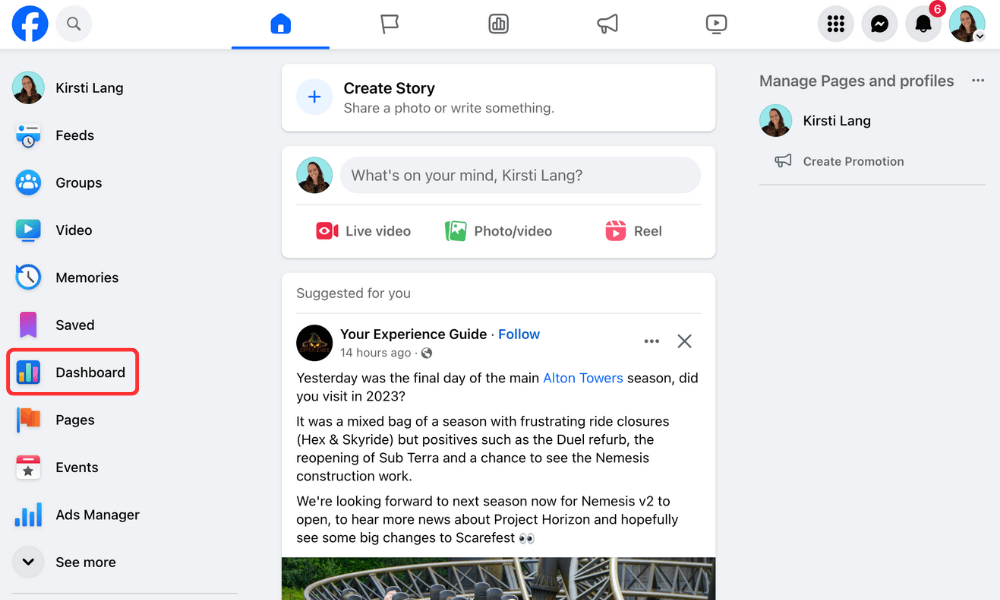
From your dashboard, you'll find a high-level overview of your content performance. Click on See more insights on the top right for more.
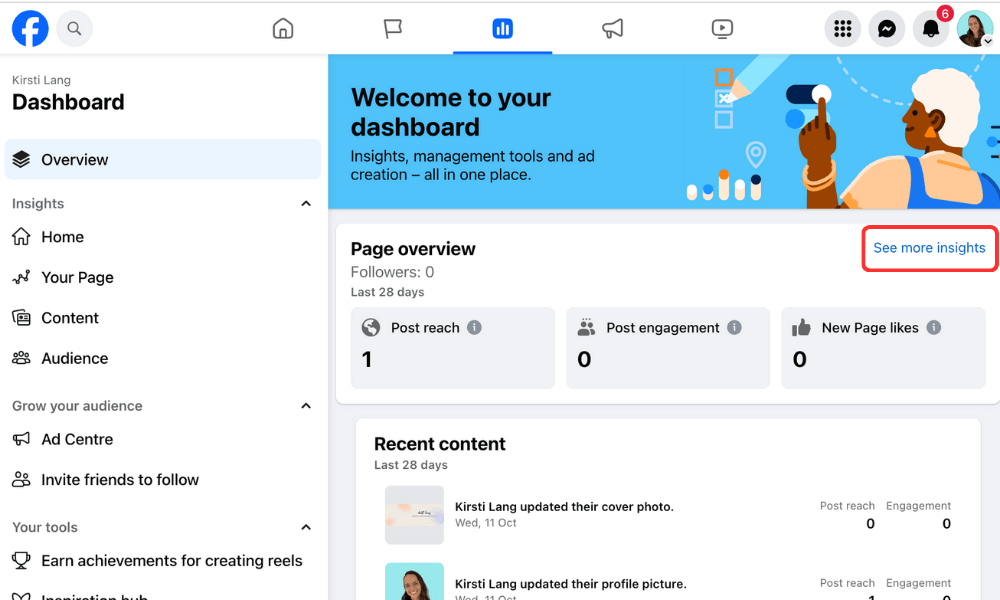
To go deeper still, click the Go to Meta Business Suite button.
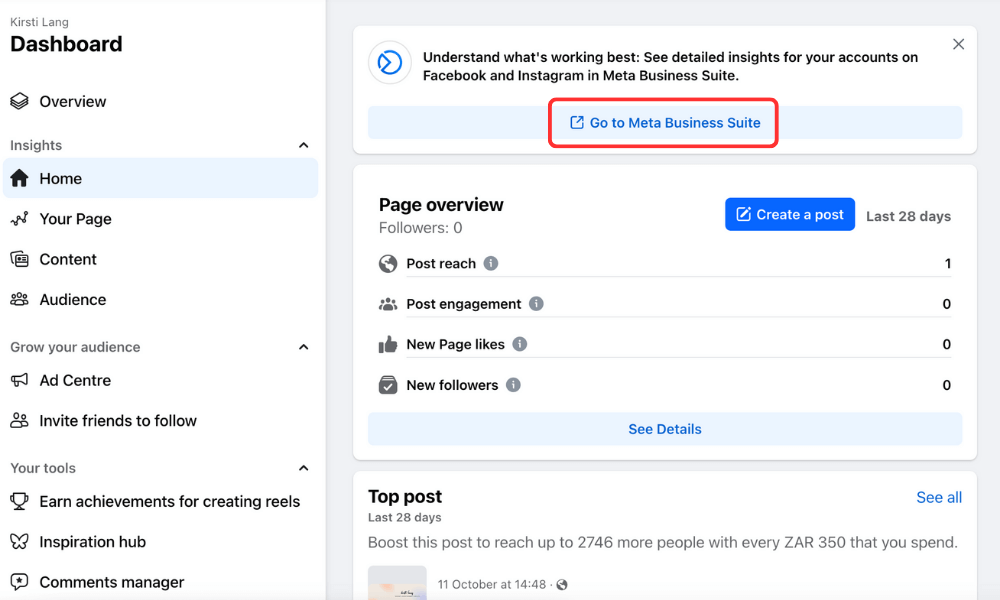
This will take you to a page like the one below, where you'll also get a look at your Instagram content analytics if you have a connected profile.
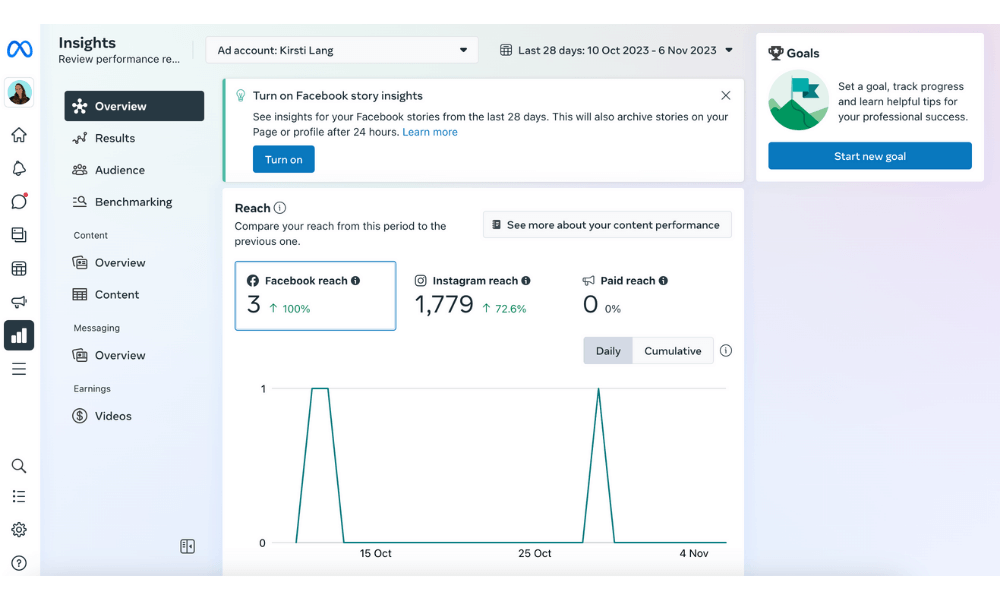
To go directly to Meta Business Suite Insights, click on your profile photo from the Facebook home page, then hit the Meta Business Suite button.
When it comes to content that resonates, Facebook has offered guidance of its own on this front. Users value accurate, authentic content, Facebook says. “So we work hard to understand what type of posts people consider genuine, so we can rank them higher in the feed. And we work to understand what kinds of stories people find misleading, sensational, and spammy, to make sure people see those less.”
Here’s their guidance for creating content that hits the mark.
- Clear headlines: “Pages should avoid headlines that withhold information required to understand what the content of the article is and headlines that exaggerate or sensationalize the article to create misleading expectations.”
- Spam: “Pages should not deliberately try to manipulate the feed to get more distribution than they normally would.”
- Accurate information: “We know there is misinformation on Facebook, and we take this very seriously. False information is harmful to our community, it makes the world less informed, and it erodes trust.”
2. Cultivate authentic engagement
Have I mentioned how much the Facebook algorithm loves engagement? Well, sharing top-notch content that resonates with your audiences isn’t the only way to generate engagement. In fact, it’s just a piece of the puzzle.
Whether you’re an influencer, creator, or brand, fostering meaningful connections with your followers will help you build a relationship and trust. That means replying to messages and reacting to and leaving thoughtful responses to their comments. These actions should be baked into your marketing strategy.
This approach will create a ripple effect: the more deeply connected your followers feel to your brand (business or personal), the more likely they are to like, comment on, or share your new content.
3. Experiment with different types of content
Text-based posts, photos, GIFs, carousels, videos, live videos — mixing up content times will help you find what achieves the best results with your audience.
Yes, that means leaning into Facebook Reels, too. While video content might feel intimidating, don’t feel as though you have to create a documentary-quality video for it to get results on the platform — Facebook loves original video content. Plus, Facebook videos have a bit of an edge on the platform as they have a separate feed for users (right next to ‘Home’ in the app) consisting almost entirely of recommended content. Here’s our everything-and-the-kitchen-sink guide to Facebook Reels to get you started.
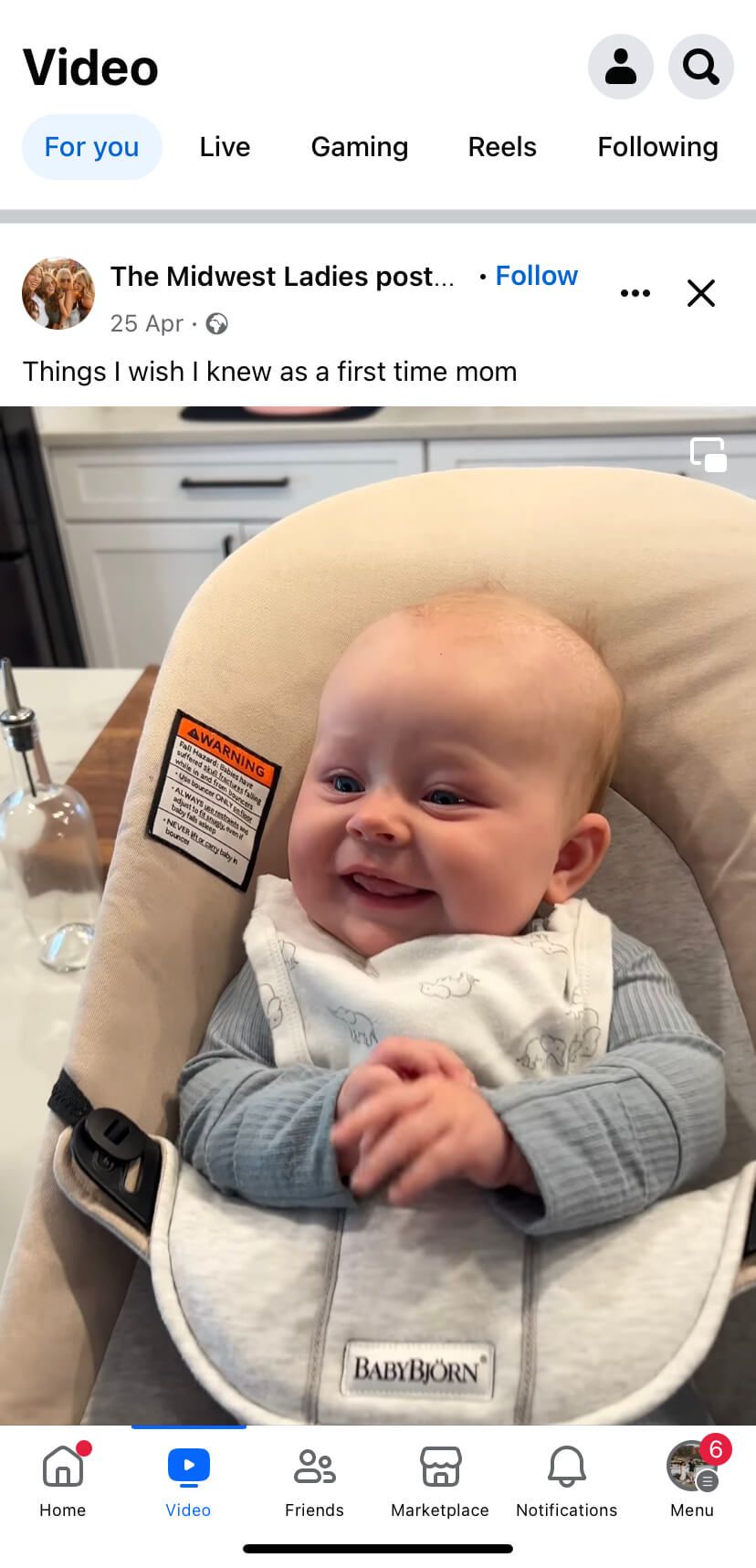
Another bonus point in short-form video content’s favor: it can be cross-posted to Instagram Reels or even repurposed for YouTube Shorts and TikTok.
4. Post user-generated content and mention people in your posts
When people tag you in posts, take notice: this is a perfect opportunity for sharing their content as UGC (or user-generated content) — with their permission of, course.
Another pro tip: Take your reviews on review sites like TrustPilot or Yelp and turn them into quick Facebook posts. Tagging the person who left the review will boost post engagement and probably get you at least one new follower (if the reviewer wasn't following you to begin with).
5. Publish posts that create meaningful conversations
Yes, we’re back on the engagement train again (this time, going in a slightly different direction): Facebook likes authentic accounts that contribute to their community and create meaningful interactions.
Facebook’s goal is to “bring people closer together and build relationships,” so posting overly promotional content that doesn't get comments or shares won't help your ranking. Interacting with other accounts also boosts your authenticity, so join other people's conversations when relevant.
6. Aim to get on people’s ‘Favorite’ lists
In 2021, Facebook added a new feature that allows users to take more control of their feeds through the Favorite list. Users can now place 30 friends and Pages they follow on their Favorite list so they see content from those friends and Pages first.
Pages and profiles can be added to Favorites by clicking on the Follow button on the Page or profile, then choosing 'Favorites'.
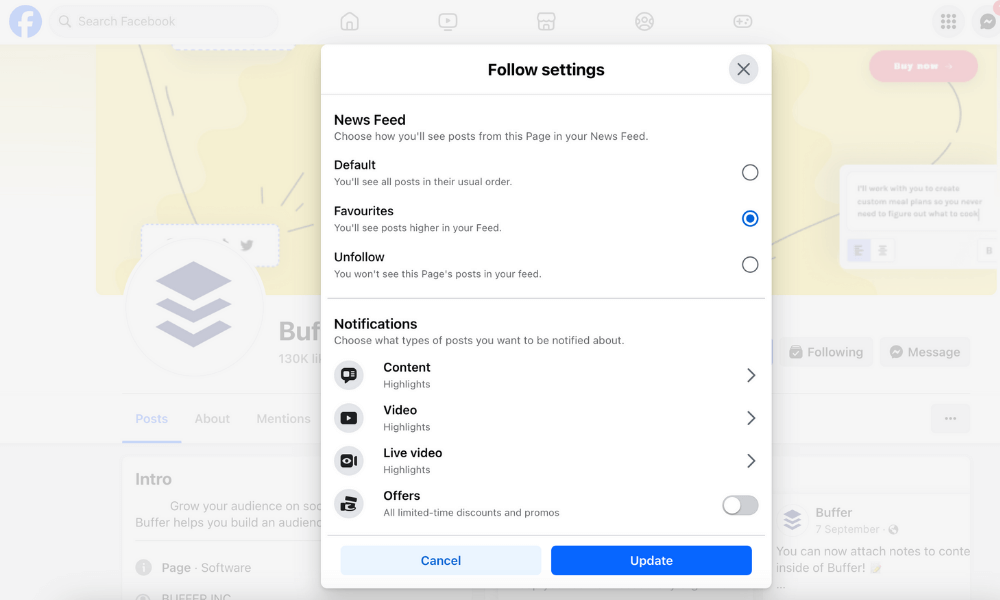
Sticking to the basics in steps 1 and 2 makes it far more likely a follower will add you to their lists.
7. Don't use clickbait and engagement bait
Facebook regularly updates its algorithm to pinpoint posts that are effectively clickbait and spammy links. Clickbait is content that is exaggerated, over-sensationalized, and borderline spam. It promises a result but doesn't deliver (e.g., headlines like “The one fruit you need to stay young”).
Engagement bait, on the other hand, uses captions or photos that contain phrases like, “Like this if you like dogs better, share this if you like cats better.”
8. Don’t share fake news
Fake news has been rampant on Facebook, so they've been doubling down on looking for signals that indicate misinformation or misdirection since 2018.
Posting fake news for whatever purpose — creating urgency, fostering fear, etc. — is against their Community Standards, and repeated offenses can get you banned from the platform.
9. Don’t violate Facebook’s Community Standards
We’ve talked about this, but it bears repeating. Facebook takes its Community Standards very seriously. The algorithm is pretty good at weeding out posts that violate these rules, but even if a post manages to skirt under the radar, Facebook users can report it and have it taken down anyway.
If your posts get removed or reported repeatedly, the overall “score” of your profile will also go down, which will lessen the visibility of your posts. In some cases, Facebook can also remove you from the platform entirely.
Don’t try to game the Facebook algorithm — work with it
There you have it: there’s no shortcut to Facebook success. Yes, it’s a long game. But high-quality, engagement-driving content that doesn’t violate any guidelines is the best way to play it. You’ll be watching those follower numbers climb in no time.





